맞닿음의 미학, 방심의 시간 – 곽경화·최홍선 작가
The Aesthetics of Touch, The Moment of Letting Go - Artists Kwak Kyounghwa and Choi Hongsun
Pairing
기아 디자인 크리에이티브 철학인 ‘오퍼짓 유나이티드(Opposites United)’의 관점에서 Paring은 두 가지 다른 개념과 의미가 결합하여, 뜻밖의 의외성을 도출하는 창의적 프로세스입니다. 이를 서로 다른 분야에서 자신만의 세계를 구축한 아티스트들이 페어링 과정을 통해 빚어낸 창의적 작품과 시너지, 그 작품이 탄생하기까지의 스토리를 통해 ‘오퍼짓 유나이티드(Opposites United)’의 근본적인 답을 찾아갑니다.
Pairing
In the context of Kia Design’s creative philosophy of Opposites United, paring is a creative process in which more than two different concepts and meanings are combined to produce something unexpected. We explore the creative works and synergies that resulted from the paring process between more than two artists who have built their own worlds in different fields, and the story of how they came to be.
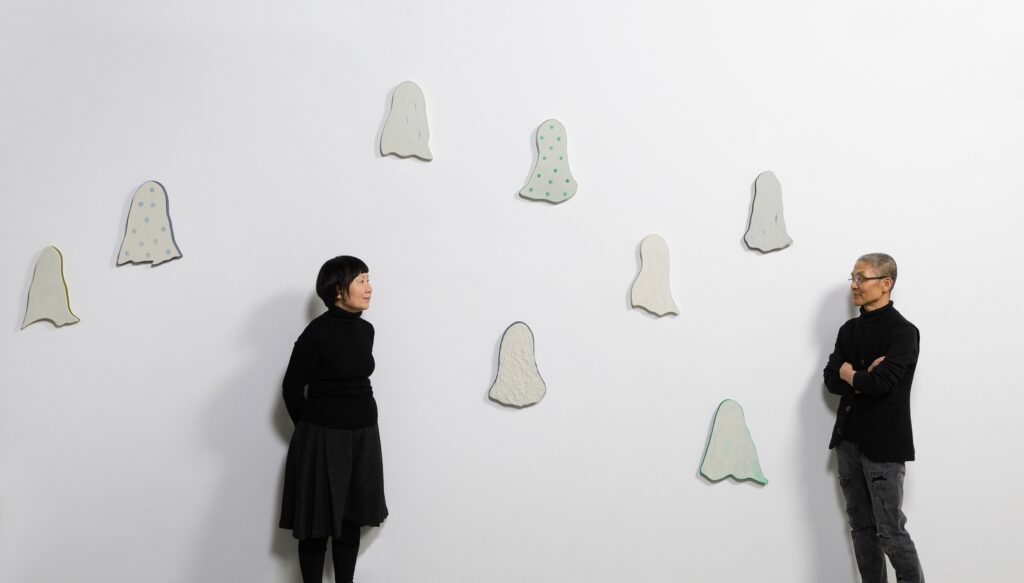
서로의 리듬을 듣고, 각자의 결을 존중하며, 다른 길 위에서도 같은 방향을 향해 나아가는 일입니다. 곽경화와 최홍선, 두 작가는 그렇게 27년의 시간을 함께 걸어왔습니다.
때로는 나란히, 때로는 다른 속도로, 그러나 언제나 같은 빛을 향해 나아가는 사람들이었습니다. 각자의 언어로 세상을 해석하지만, 그 언어는 언제나 한 지점에서 조용히 맞닿습니다. 그들의 예술은 서로 다른 색의 파동이 한 줄기의 결로 이어질 때 완성됩니다. 《두 개의 방이 있는 집》과 《맞닿음에 관한 이야기》는 그 긴 여정이 만들어낸 하나의 풍경입니다. 그들에게 협업은 타협이 아닙니다. 한쪽이 다른 한쪽을 덮거나 맞추는 일이 아니라, 서로의 감각을 이해하고 존중하며 조율하는 일입니다. 그 공존의 중심에는 ‘방심(放心)의 미’라는 태도가 있습니다.
《기아 디자인 매거진》 16호 ‘Pairing’에서는 각자의 세계를 지키면서도 서로에게 스며드는 두 작가의 이야기를 담았습니다.Listening to one another’s rhythm, honouring each other’s grain, and keeping on walking towards the same light, even if you are on different paths.
This is how artists Kwak Kyounghwa and Choi Hongsun have shared the past twenty-seven years. Sometimes side by side, sometimes at a different pace, yet always drawn by the same radiance.
They each interpret the world in their own language, but their expressions quietly meet at a single point. Their art finds completion when two distinct waves of color converge into one subtle texture. A House with Two Rooms and A Story About Touching Points unfold as landscapes born of that long journey.
For them, collaboration is not a matter of compromise. It is not about one subsuming the other, but about listening, understanding, and adjusting until a shared harmony emerges. At the heart of their coexistence lies an attitude they call the beauty of letting go.
In Kia Design Magazine Vol. 16 Pairing, their story reflects what it means to preserve one’s own world while quietly blending into another’s.
- 두 개의 방
그리고 맞닿음 - 서로의 문을 열어
같은 곳을 바라보다 - 완벽을 넘어선 아름다움을 위한
방심의 미
- Two Rooms
And Where They Meet - Opening Each Other’s Doors,
Looking Toward the Same Horizon - The Beauty of Letting Go,
Where Perfection Yields to Grace
Editor’s Note
처음 두 사람의 작품을 마주했을 때, 저는 잠시 혼란스러웠습니다. 이것이 곽경화 작가의 작품인지, 최홍선 작가의 작품인지 구분할 수 없었기 때문입니다. 서로 다른 언어로 출발했지만, 그 언어는 어느새 같은 문장으로 이어져 있었습니다. 두 사람의 세계는 닮아 있습니다. 그러나 그 닮음은 모방이 아니라 공명에 가깝습니다. 하얀 화면과 낮은 채도의 색, 쌓이고 지워진 붓질의 결 속에서 두 사람의 시간이, 호흡이, 그리고 삶의 온도가 겹쳐집니다. 이질감 대신 느껴지는 것은 조용한 어울림입니다. 《기아 디자인 매거진》 16호 ‘Pairing’에서 그들의 작업을 바라보며, 그들의 이야기에 귀 기울이며 ‘맞닿음’의 미학에 대해 생각해보시기 바랍니다.
Editor’s Note
When I first encountered the works of Kwak Kyounghwa and Choi Hongsun, I felt a moment of confusion. I could not tell whose work I was looking at, hers or his. Although they began from different artistic languages, those languages have quietly merged into a single sentence.
Their worlds resemble one another, yet that resemblance is not imitation but resonance. Within white spaces and muted tones, in the layered and erased traces of their brushstrokes, their time, breath, and the temperature of their lives overlap.
What arises is not dissonance but a quiet harmony. In Kia Design Magazine No.16 Pairing, we invite you to look closely at their works, to listen to their shared story, and to contemplate the subtle beauty of connection, the aesthetics of touching points.
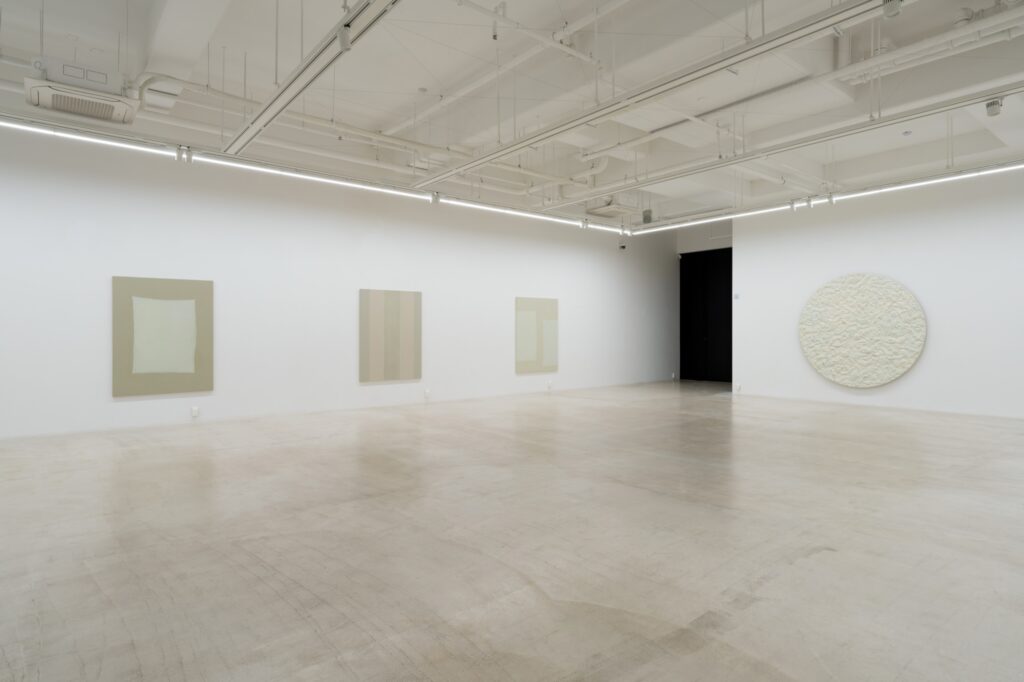
Chapter 01.
두 개의 방
그리고 맞닿음
Chapter 01.
Two Rooms
And Where They Meet
곽경화·최홍선 두 작가는
서로 다른 언어로 자신의 이야기를 짓지만, 그 이야기는 자연스럽게 맞닿는다.
공존에서 시작해 스며듦으로 이어지기 때문이다.Kwak Kyounghwa and Choi Hongsun each tell their own stories in different languages, yet these narratives naturally converge.
This is because their work begins with coexistence and evolves into permeation.
Q. 부부이지만 각자의 영역에서 오랫동안 활동해온 두 작가의 만남이 궁금합니다. 두 분의 ‘페어링’은 언제부터 시작되었나요?
최홍선: 저희는 늘 같은 공간을 공유하며 작업했지만, 그게 곧 협업을 의미하진 않았어요. 각자의 작업 언어가 명확했고, 한 작품을 공동으로 만든 적은 없었거든요. 서로의 세계를 존중하면서 각자의 궤도에서 성장해왔습니다.
하지만 스튜디오라는 공간 안에서 매일의 호흡을 나누다 보니, 어느 순간 그 경계가 아주 자연스럽게 흔들리기 시작했습니다. 2023년에 전시한 《두 개의 방이 있는 집》은 그 경계가 드러난 첫 번째 전시였어요.
곽경화: 저희가 함께한 첫 전시지만, 사실 그건 어느 날 갑자기 이루어진 ‘협업’이 아니라 오랜 시간의 ‘공존’에서 비롯된 결과였어요. 서로의 작업을 지켜보면서 자라온 감정, 대화, 일상의 조각들이 쌓여서 어느 날 자연스럽게 한 방향을 향하게 된 거죠. 이번 전시는 그런 ‘자연스러움’의 결과물이었습니다. 의도적인 기획보다, 오히려 아주 느리게 침전된 시간들이 만들어낸 만남이었어요.
Q. 첫 시작인 《두 개의 방이 있는 집》이라는 전시 타이틀이 확 와닿는 것 같아요. 어떤 의도로 기획을 하셨나요?
곽경화: 이 전시의 시작은 제가 2007년에 방문했던 독일 인젤 홈브로이흐 미술관(Museum Insel Hombroich)이었어요. 그곳은 ‘자연과 예술의 공존’을 경험할 수 있는 독특한 미술관이에요. 작품에는 이름표도, 안내문도 없고, 관람객은 단지 걷고, 멈추고, 바라보는 경험을 합니다. 그 공간에선 거장과 무명, 현대작품과 고대유물이 모두 동일한 밀도로 존재하죠. 어느 것도 우열이 없고, 보는 사람의 시선이 모든 것을 완성합니다. 그 경험이 제게는 강렬하게 남았어요.
최홍선: 저 역시 그 이야기를 함께 보면서 공감했어요. 예술의 주체가 작가나 제도가 아니라 ‘공간과 관람자’라는 점에서 많은 생각을 하게 되었거든요. 그래서 《두 개의 방이 있는 집》은 단순히 물리적 구조를 의미하지 않았어요. 서로 다른 두 작가가 한 집 안에서, 각자의 세계를 유지하면서도 그 경계가 자연스럽게 스며드는 풍경을 만들고 싶었습니다.
‘두 개의 방’은 우리 둘을 의미하면서, 동시에 관객이 머무는 ‘세 번째 공간’을 암시하기도 했습니다.
Q. As a married couple who have both worked independently for so long, I’m curious about how you met When did your ‘pairing’ begin?
Choi: We always shared the same space while working, but that didn’t necessarily mean we were collaborating. Our respective artistic languages were distinct, and we had never created a joint piece. We respected each other’s worlds and grew along our own trajectories.
However, sharing daily rhythms within the studio space, the boundaries between us began to shift very naturally at some point. The exhibition ‘A House with Two Rooms’, shown in 2023, was the first exhibition where that boundary became visible.
Kwak: Although it was our first joint exhibition, it wasn’t a sudden ‘collaboration’ that happened overnight. It was the result of a long period of ‘coexistence’. The emotions, conversations, and fragments of daily life that accumulated while watching each other’s work naturally led us in one direction one day. This exhibition was the outcome of that ‘naturalness’. It was less an intentional plan and more a an idea that had slowly evolved over time.
Q. The exhibition title, ‘A House with Two Rooms’, seems very appropriate as a starting point. What was your intention in planning it?
Kwak: The starting point for this exhibition was my visit to the Museum Insel Hombroich in Germany in 2007. It’s a unique museum where you can experience the ‘coexistence of nature and art’. There are no labels or guides for the artworks; visitors simply walk, pause, and observe. Within that space, masters and unknown artists, contemporary pieces and ancient artifacts all exist with equal density. Nothing is superior or inferior; the viewer’s gaze completes everything. That experience left a profound impression on me.
Choi: I empathised deeply with that story as well. It made me think deeply about how the subject of art is not the artist or the institution, but rather ‘the space and the viewer’. So, 《A House with Two Rooms》 didn’t simply refer to a physical structure. I wanted to create a landscape where two different artists, within one house, maintain their own worlds while their boundaries naturally blend.
‘Two rooms’ signified the two of us, while simultaneously hinting at a ‘third space’ where the audience resides.
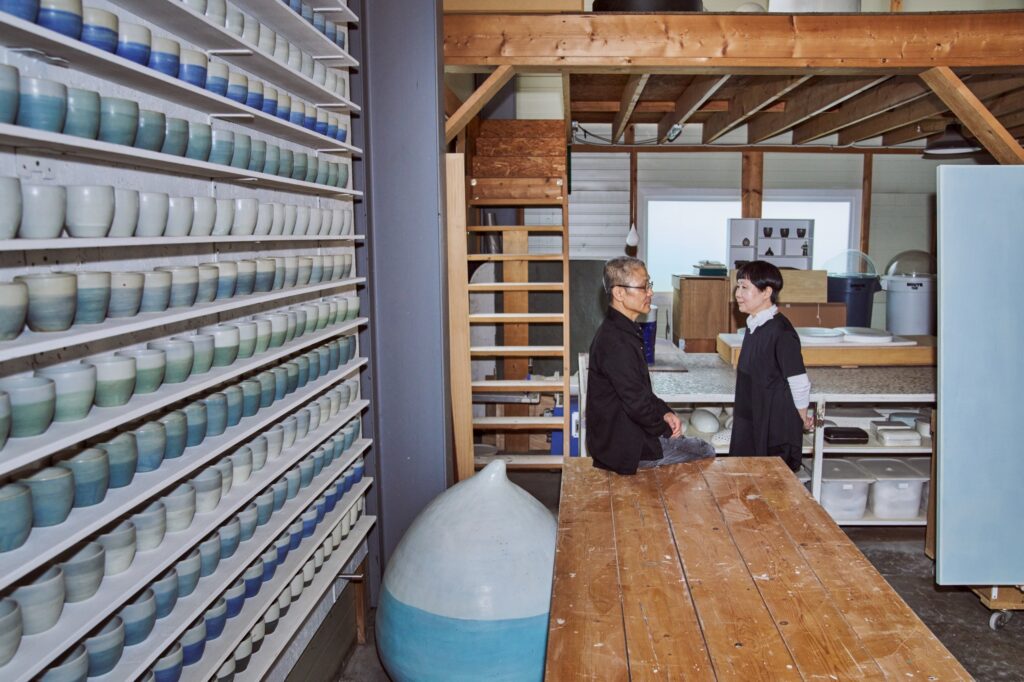
Q. 《두 개의 방이 있는 집》 전시는 말 그래도 방 두 곳에 각각 자신들의 작품을 둔 거에요. 그런데도 이질성 보다는 조화롭다는 점이 재미있어요. 마치 한 공간 안에서 자연스럽게 ‘맞닿는’ 느낌이 있습니다. 그 이유를 어떻게 생각하시나요?
곽경화: 맞아요. 저희 둘의 작업은 처음엔 결이 확실히 달랐어요. 최홍선 작가는 흰색의 결, 아주 미세한 색의 움직임 안에서 사유하는 회화를 하고, 저는 색을 쓰지만 굉장히 낮은 채도와 명도의 세계를 다루죠. 그런데 이상하게도 두 작업이 같은 공간에 놓이면 서로 밀어내지 않고 오히려 스며듭니다. 그건 아마도 저희가 바라보는 방향이 같기 때문인 것 같아요. 눈에 보이는 형상보다 그 안의 시간, 감정, 흔적 같은 것들을 담으려는 태도요. 그래서 《맞닿음에 관한 이야기》 전시에서도 그걸 의식적으로 풀어내고자 했어요. 서로 다른 재료와 색을 쓰지만, 그 안에서 자연스럽게 이어지는 감정의 흐름, 빛의 농도, 공기의 결이 있습니다. 결국 저희에게 맞닿음이란 ‘같은 것을 그리는 일’이 아니라 ‘다른 길에서 같은 중심을 향하는 일’이에요.
최홍선: 저도 그렇게 생각합니다. 맞닿음은 시각적인 조화보다 더 근본적인 감각이에요. 각자의 언어로 세상을 표현하지만, 그 깊은 층에서는 같은 리듬으로 호흡하고 있다는 걸 느껴요. 이건 부부이기 때문이 아니라, 오랜 시간 서로의 변화를 지켜보며 쌓인 신뢰의 결과입니다. 그런 신뢰가 있을 때, 서로의 경계가 자연스럽게 흔들리고 겹쳐질 수 있는 거죠.
Q. In ‘A House with Two Rooms’, each of you placed your works in separate rooms, yet the space feels more harmonious than divided. There is a natural sense of connection, as if the two rooms touch each other gently within the same atmosphere. What do you think makes that possible?
Kwak: That’s true. Our works were quite different at first. Hongsun’s paintings are meditative, exploring the subtle movement of white and the faintest shifts of color. I also work with color, but within a restrained spectrum of low saturation and dim brightness. Strangely, when our works are placed together, they don’t resist each other. They blend.
I think that’s because we share the same direction in how we look at the world. We both try to capture not the visible form itself, but the time, emotion, and trace that dwell within it. In A Story About Touching Points, we wanted to bring that sensibility forward — the flow of emotion, the density of light, the texture of air that naturally connects across different materials and colors.
For us, “connection” is not about painting the same thing. It is about walking different paths toward the same center.
Choi: I feel the same way. Connection is a deeper concept than visual harmony. We may express the world in different languages, but on a deeper level, I believe we breathe in the same rhythm. This isn’t just because we’re a couple, it’s because we’ve witnessed each other’s changes over a long time. That shared trust allows our boundaries to soften, overlap, and move together.
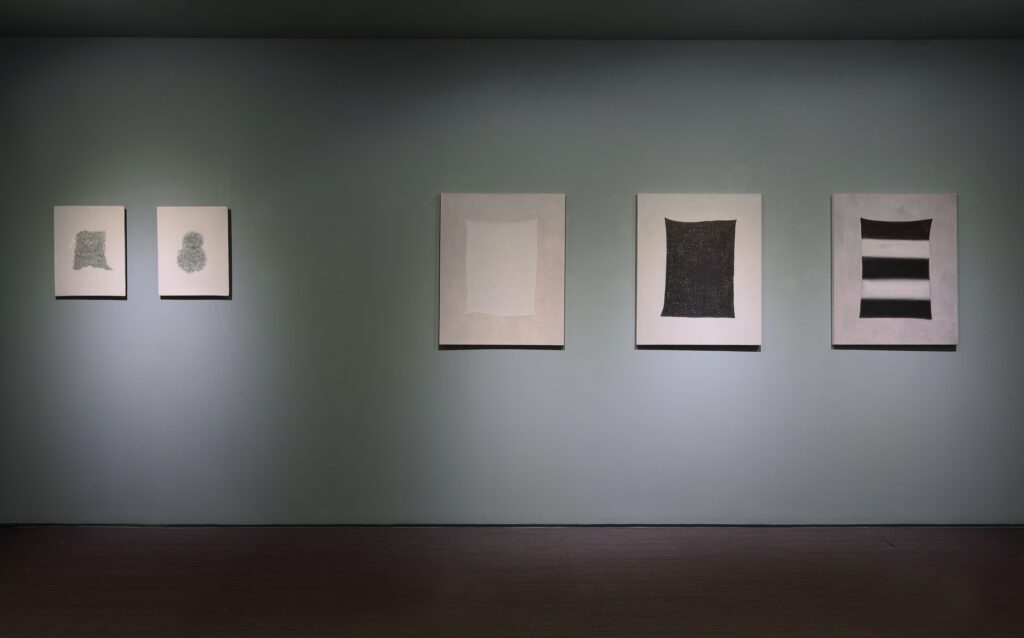
Q. 이쯤에서 《맞닿음에 관한 이야기》 이야기를 하지 않을 수가 없어요. 이번에는 어떤 이야기를 들려주고 싶었나요?
최홍선: 전시 제목의 부제인 ‘The Tale’은 이야기라는 뜻이지만, 단순히 스토리를 말하는 건 아니었어요. 고전소설 장화홍련전에서 영감을 받았는데, 그 자매의 관계처럼 두 사람의 세계가 다르지만 묘하게 연결되어 있다는 점이 흥미로웠어요. 그걸 ‘홍경화전’이라고 이름 붙일까도 했지만, ‘Tale’이라는 단어가 더 자유롭고 열린 해석을 가능하게 해주더군요. 《맞닿음에 관한 이야기》는 결국 서로 다른 예술 언어가 하나의 공간 안에서 만들어내는 ‘관계의 이야기’예요. 관객이 전시장(두 개의 방)을 거닐다 보면, 어느 순간 그 경계가 사라지고 두 세계가 자연스럽게 한 호흡으로 느껴지길 바랬습니다.
곽경화: 이번 전시는 두 사람의 작업이 왜 그렇게 자연스럽게 어우러지는지를 스스로에게 묻는 과정이었어요. 왜 그런 걸까 생각하다가 ‘맞닿음’이라는 단어로 정리하게 됐죠. 서로 다른 매체와 색을 쓰지만, 작업의 근저에는 닮은 감정의 결이 있었어요. 결국 저희가 이번 전시를 통해 보여주고 싶었던 건, 각자 다른 길을 걷지만 그 끝에서 만나는 ‘온도의 순간’이에요. 작품이 서로를 압도하거나 간섭하지 않고, 공기처럼 자연스럽게 스며드는 풍경을 만들어 보고 싶었습니다.
Q. At this point, I can’t help but talk about ‘The Tale, A Story of Touch.’ What kind of story did you want to tell this time?
Choi: The subtitle ‘The Tale’ in the exhibition title means ‘story,’ but it wasn’t just about a narrative. I was inspired by the classical novel Janghwa Hongnyeonjeon*. Like the sisters in that story, I found it fascinating that two people’s worlds could be different yet strangely connected. I considered naming it ‘The Tale of Hongsung and Gyeonghwa,’ but the word ‘Tale’ allowed for a freer, more open interpretation. ‘A Tale of Touch’ is ultimately a ‘story of relationships’ created by different artistic languages within a single space. I hoped that as viewers wandered through the exhibition space (two rooms), the boundary would dissolve at some point, and the two worlds would naturally feel like one breath.
Kwak: This exhibition was a process of asking ourselves why our two practices blend so naturally. Pondering why led us to the word ‘touching.’ Though we use different media and colors, there was a similar emotional texture at the core of our work. Ultimately, what we wanted to show through this exhibition is the ‘moment of warmth’ we encounter at the end of our separate paths. We aimed to create a landscape where the works neither overwhelm nor interfere with each other, but blend together as naturally as air.
* “Janghwa Hongryeonjeon” is a traditional Korean folktale passed down since the Joseon Dynasty, telling the tragic story of two sisters, Janghwa (Rose Blossom) and Hongryeon (Red Lotus).
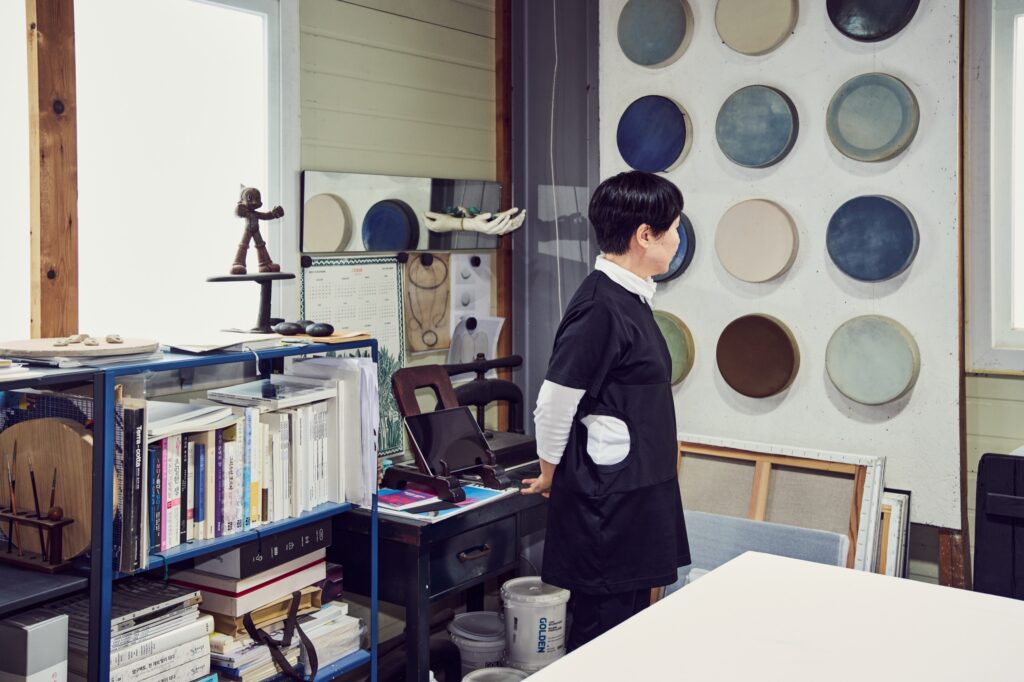
Chapter 02.
서로의 문을 열어
같은 곳을 바라보다
Chapter 02.
Opening Each Other’s Doors,
Looking Toward the Same Horizon
하루에도 수십 번, 작품의 자리를 바꾸며 감정을 조율한다.
공존은 그렇게 만들어진다.
논리가 아닌, 감각이 동시에 멈추는 자리에서.Dozens of times a day, they move their works, adjusting the emotions between them. Coexistence is created in this way, not from logic, but from the place where two senses come to rest at once.
Q. 27년차 부부인데다 같은 공간에서 작업을 하면 서로 영향을 주기도 하고, 충돌할 때도 있을 것 같아요.
곽경화: 네, 그건 피할 수 없는 일 같아요. 지금의 작업실을 함께 쓴 지도 벌써 7년이 넘었는데, 처음엔 각자의 방이 완전히 분리되어 있었거든요. 하지만 이제는 한 공간을 공유하다 보니 자연스럽게 서로의 과정을 보게 돼요. 그게 좋은 자극이 되기도 하고, 가끔은 ‘저렇게 집중해야겠다’ 하며 반성하게 되죠. 입체를 하는 사람은 평면의 감각에 끌리고, 회화를 하는 사람은 조형의 구조에 호기심을 느끼는 것처럼요. 서로 다른 세계지만, 그 차이가 오히려 동력이 됩니다.
최홍선: 저도 그래요. 함께 있다 보면 내 작업을 다시 보게 되는 순간이 있어요. 힘이 들 때 곽경화 작가가 묵묵히 그리는 모습을 보면 ‘나도 다시 집중해야겠다’는 생각이 듭니다. 그런 식으로 서로를 바라보며 배우고 반성하는 관계예요.
그래서 우리는 부딪히기보단, 조용히 영향을 주고받는 쪽에 가깝습니다.
Q. 하지만 서로의 시작이 다르기도 했고, 두 분이 함께 작품을 만들어가는 것이 아니기에 자신만의 방을 가지고 있는 것도 중요할 것 같은데요.
곽경화: 맞아요. 저희는 각자의 시간과 기억, 감정을 토대로 독립적인 세계를 구축해왔어요. 그건 서로를 존중하기 위한 기본이기도 했죠. 그래서 같은 공간 안에서도 작업의 방식이나 속도는 전혀 다릅니다. 저는 색을 다루지만, 그 색이 ‘사라지는 감정’을 표현해요. 꿈이나 그림자, 눈물처럼 부서지는 감정의 단면을 포착하려고 하죠. 그래서 색을 쓰되, 채도와 명도를 최대한 낮춥니다. 그게 제 감정의 언어이자, 기억을 다루는 방식이에요.
최홍선: 저는 도예를 기반으로 시작했어요. 흙을 만지는 물성과 그 속에 쌓이는 시간의 감각이 제 작업의 뿌리입니다. 반복적인 붓질로 색층을 쌓아가는 것도 그 연장선상에 있죠. 그래서 제 작업은 손의 감각과 시간의 흐름을 기록하는 행위에 가깝습니다. 곽경화 작가의 회화가 감정의 잔상을 다룬다면, 저는 그 감정을 담을 수 있는 여백의 공간을 만들고 싶어요.
Q. You have been married for 27 years and now work together in the same studio. I imagine you influence each other, but there must also be moments of tension.
Kwak: Yes, that’s something we can’t really avoid. We have shared our current studio for more than seven years now. At first, our rooms were completely separate, but as we began to share one space, we naturally started seeing each other’s process. Sometimes it becomes a good source of inspiration, and at other times it makes me reflect, thinking, “I should focus like that too.”
A sculptor is drawn to the sense of the plane, and a painter becomes curious about the structure of form. Our worlds are different, yet that difference becomes a kind of energy.
Choi: I feel the same. There are moments when being together makes me look at my own work again. When I feel exhausted, seeing Kyounghwa quietly painting makes me want to concentrate once more. Our relationship is built on observing, learning, and reflecting through each other. Rather than clashing, we quietly influence each other.
Q. Since you had different beginnings and now pursue independent work rather than creating together, maintaining your own space must also be important.
Kwak: That’s right. We have each built our own worlds based on our personal experiences, memories and emotions. It is also a way of respecting each other. Even when working in the same space, our working methods and rhythms are completely different. I work with color, but my intention is to express the emotion of disappearance. I try to capture the fragile moments of feeling, like dreams, shadows, or tears. That is why I use color with the lowest possible saturation and brightness. It is the language of my emotions, the way I handle memory.
Choi: My background is in ceramics. The tactile nature of clay and the sense of time embedded within it are at the root of my work. The repeated layering of brushstrokes continues from that foundation. My practice is close to an act of recording the feeling of the hand and the passage of time While Kyounghwa’s paintings capture the traces of emotion, I aim to create a void that can contain those emotions.
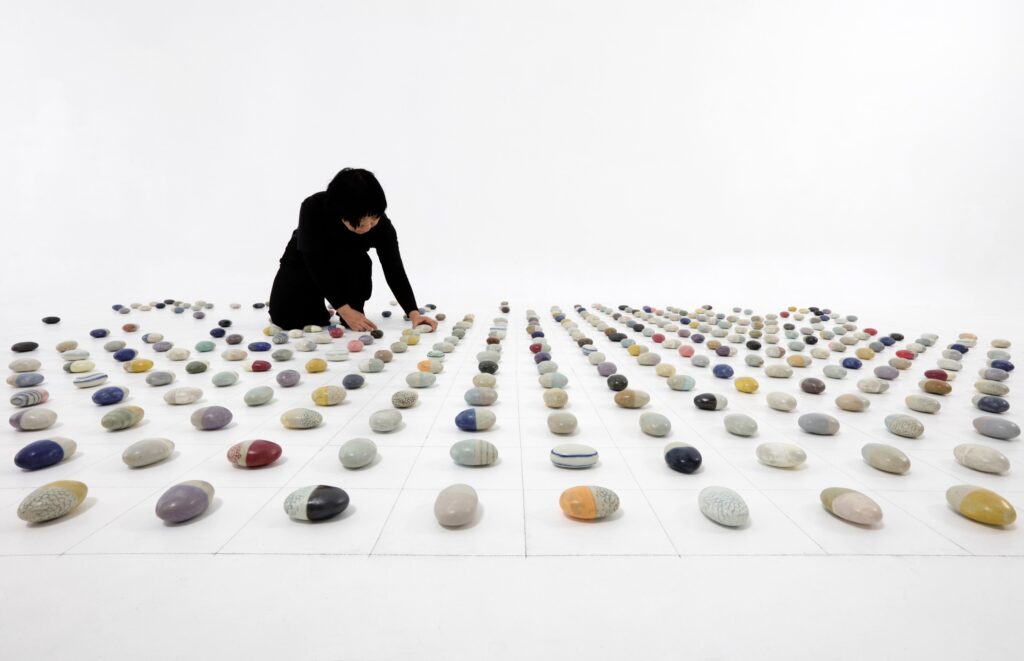
Q. 그렇다면 전시에 있어 두 작가의 개성은 남겨두되, 하나로 잇기 위한 과정이 쉽지 않았을 것 같아요.
최홍선: 네, 그 부분이 정말 어렵고 또 중요합니다. 저희는 전시장에 들어가기 전, 실제 설치를 하기 전에 미리 ‘시뮬레이션’을 해요. 도면을 보고 실제 공간 비율대로 벽 높이, 거리, 조도를 맞춰서 작업실 안에 재현해요. 일종의 리허설이죠. 작품 이미지들을 실제 비율로 배치해보면서 어떤 작품이 옆에 있을 때 서로 밀어내지 않고, 자연스럽게 호흡하는지를 찾는 거죠. 그 과정이 하루 이틀이 아니라 길게는 두 달 가까이 이어지기도 합니다.
곽경화: 맞아요. 그 시간이 저희에게는 일종의 실험 같아요. 서로의 작품을 계속 옮겨보면서 간격을 조정하고, 조명 각도까지 바꿔가며 감정의 흐름을 맞춰가죠. 어떤 작품은 옆에 두면 갑자기 기운이 죽기도 하고, 또 어떤 건 나란히 있을 때 훨씬 살아나요. 그걸 찾아가는 시간이 정말 오래 걸려요. 그렇게 시뮬레이션을 반복하다 보면, 어느 순간 두 사람이 동시에 “이게 맞다”고 느끼는 지점이 생깁니다. 그 순간이 오면 더 이상 손대지 않아요. 그건 타협이 아니라, 두 감각이 하나로 이어지는 순간에 가까워요.
Q. 시뮬레이션이 굉장히 재미있는 발상인데요. 그 부분이 왜 중요하다고 생각하나요?
최홍선: 저희에게 시뮬레이션은 단순한 설치 준비가 아니에요. 하나의 실험이고, 또 작업의 연장선이죠. 완성된 작품을 공간에 어떻게 두느냐에 따라 감정의 결이 전혀 달라지거든요. 그래서 그걸 계속 바꿔보고, 간격을 조정하고, 조명을 옮겨보면서 작품이 호흡하는 방식을 찾습니다. 저는 그 시간이 굉장히 중요하다고 생각해요. 작품이 단독으로 존재할 때는 느껴지지 않던 감정이, 다른 작품 옆에 있을 때 생겨나는 경우가 많거든요. 그건 이론으로 풀 수 있는 게 아니라, 몸으로 느껴야 알 수 있는 일이라 늘 직접 눈으로 확인합니다.
곽경화: 네, 저희에게 시뮬레이션은 ‘결정’이라기보다 ‘탐색’에 가까워요. 하루에도 몇 번씩 작품 위치를 바꾸고, 조명을 켰다 껐다 하면서 그 미묘한 차이를 봐요. 어떤 날은 그걸로 하루가 다 가기도 하죠. 그런데 이상하게도 그렇게 계속 보다 보면 어느 순간 “여기야” 하는 순간이 와요. 두 사람이 동시에 같은 느낌을 받을 때가 있거든요. 그게 참 신기해요. 계산이나 논리로 맞추는 게 아니라, 감각이 맞닿는 순간이 오는 거죠. 그런 의미에서 시뮬레이션은 저희에게 ‘전시를 완성하는 과정’이라기보다, ‘서로의 감각을 맞춰가는 시간’이라고 말할 수 있을 것 같아요.
Q. 작품 활동부터 시뮬레이션과 전시까지 하나부터 열까지 모든 일을 다하시는데요. 두 분에게 전시는 어떤 의미인가요?
최홍선: 전시는 저희에게 하나의 ‘여행’이에요. 새로운 공간에서 새로운 시선을 만나고, 관객과 감정을 교류하는 여정이죠. 작품을 설치하는 일은 단순히 결과물을 보여주는 게 아니라, 그동안의 시간과 사유를 정리하는 과정이에요. 전시를 마치고 나면 언제나 이전과는 조금 다른 나를 발견하게 됩니다.
곽경화: 그 여행에는 늘 ‘우연’이 섞여 있어요. 계획한 대로 되지 않지만, 그 안에서 뜻밖의 아름다움이 생깁니다. 때로는 설치 도중 생긴 빛의 굴절이나 그림자의 방향이 예상치 못한 감정을 만들어내기도 하죠. 그래서 전시를 단순한 결과가 아닌 과정으로 받아들여요. 그 시간이 우리의 감정과 관계를 더 단단하게 만들어주거든요.
Q. It must have been challenging to preserve each of your artistic identities while creating a unified exhibition.
Choi: Yes, that part is both the most difficult and the most essential. Before we enter the actual gallery, we conduct a kind of simulation. We recreate the exhibition space inside our studio, matching wall height, distance, and lighting according to the real floor plan. It is like a rehearsal. We arrange the works to scale and see how they interact with each other, searching for compositions where they complement each other rather than overpowering one another.. This process can take days, sometimes even two months.
Kwak: For us, that time feels like an experiment. We keep moving our works, adjusting the distance, changing the lighting angle, and following the flow of emotion. Some pieces lose energy when placed side by side, while others come alive only in proximity. It takes a long time to find the right balance. But there always comes a moment when we both feel at once, “This is it.” When that happens, we stop. It is not compromise, but a moment when two senses naturally align.
Q. The idea of simulation is fascinating. Why is this process so important to you?
Choi: For us, simulation is more than just preparation for installation. It is an extension of the work itself. The emotional texture changes completely depending on how a finished piece is placed in space. We keep rearranging, adjusting the distance, shifting the light, and watching how the works breathe. I find that process deeply meaningful. There are emotions that only appear when one work exists beside another. It is not something theory can explain; it is something the body must feel and the eyes must confirm.
Kwak: Yes, for us, simulation is more about exploration than decision. We move the works several times a day, turning the lights on and off, watching the subtle differences. Sometimes a whole day passes like that. But strangely, after all that looking, there comes a quiet moment when we both feel, “Here it is.” It is not logic or calculation but a moment when our senses meet. In that sense, simulation is not just a way to complete an exhibition, but a time to attune our sensibilities.
Q. From creation to simulation to exhibition, you do everything yourselves. What does an exhibition mean to you?
Choi: For us, an exhibition is a journey. It is a process of meeting a new space, encountering new perspectives, and exchanging emotions with the audience. Installing the works is not merely about displaying results, but about organizing the time and thought that have accumulated within them. After each exhibition, I always find a slightly different version of myself.
Kwak: There is always an element of chance in that journey. Things never go exactly as planned, but unexpected beauty often emerges within that unpredictability. Sometimes a shift in light or the angle of a shadow creates an emotion we never anticipated. That is why we see the exhibition not as an end, but as a process. It strengthens not only our work, but also our relationship and the emotions that sustain it.

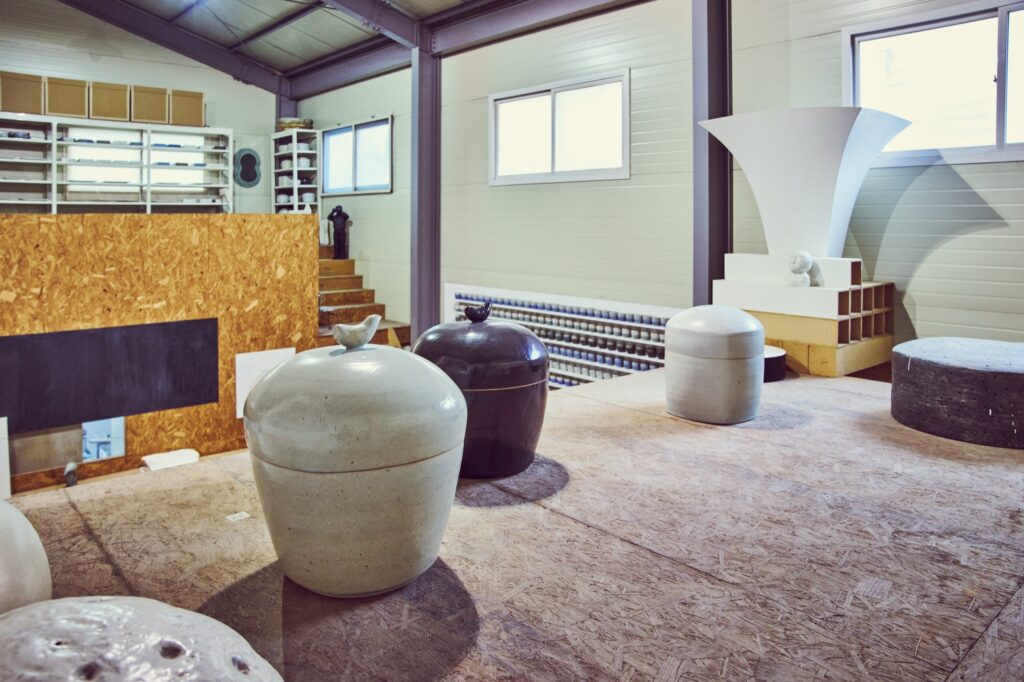
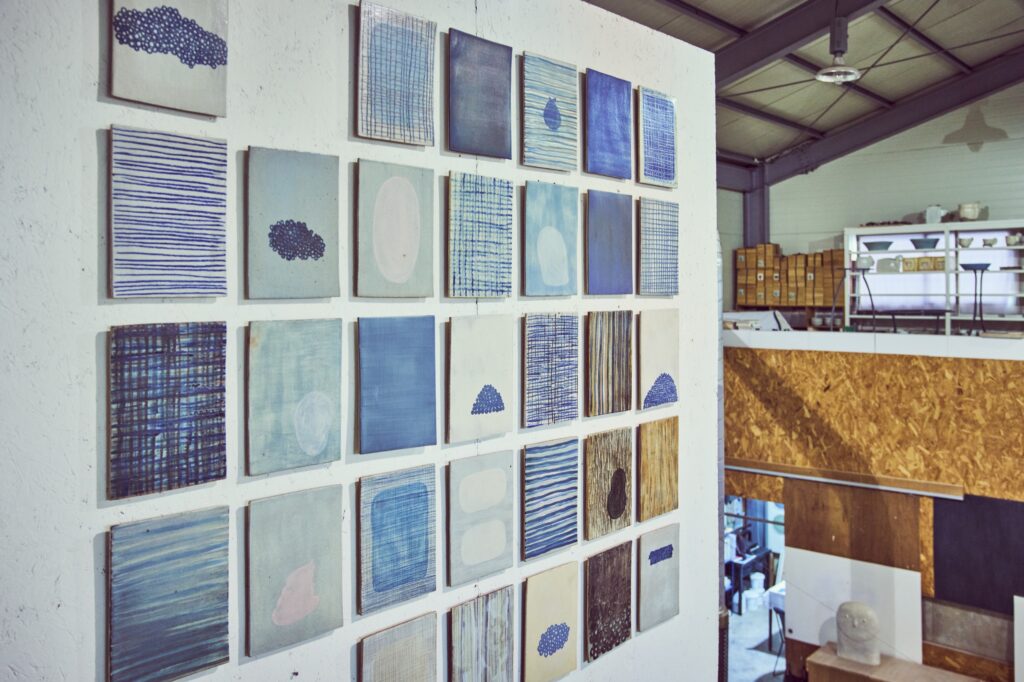
Chapter 03.
완벽을 넘어선 아름다움을 위한
방심의 미
Chapter 03.
The Beauty of Letting Go,
Where Perfection Yields to Grace
완벽을 향하지만, 끝내 내려놓는 순간에 피어나는 아름다움.
두 세계가 겹치며 만들어내는 미묘한 온도와 숨결.
그 틈에서 예술은, 그리고 삶은 비로소 호흡을 시작한다.Reaching for perfection, yet finding beauty only in the moment of release.
Where two worlds overlap, a subtle warmth and breath begin to form.
In that quiet space between them, art and life finally begin to breathe.
Q. 시뮬레이션 이야기를 들으면 굉장히 완벽에 가깝고자 하는 태도처럼 느껴집니다. 그런데 작가님은 ‘마음을 놓는 방심(放心)의 미’로 다가가고 싶다고 하셨죠. 그 의미가 궁금합니다.
최홍선: ‘방심(放心)’의 ‘방(放)’은 놓을 방이에요. 마음을 내려놓는다는 뜻이 맞아요. 예컨대 달항아리를 보면, 완벽하게 둥근 형태에는 이상하게 마음이 잘 가지 않아요. 하지만 살짝 기운 모양새에서는 시선이 머물게 되죠. 그 안에는 원형의 단정함과 인간적인 미가 동시에 존재합니다. 저는 그 순간이 참 흥미로워요. 완벽하다고 믿는 순간에 오히려 허를 찔리는 감정, 그게 예술이 주는 긴장감이자 아름다움이라고 생각합니다.
곽경화: 저에게도 ‘방심의 미’는 자연스러움을 허락하는 일이에요. 흰 화면 위에 수십 번의 붓질이 겹치고, 사라지고, 다시 쌓이면서 생기는 미세한 흔들림이 결국 작품의 숨결이 되죠. 눈에는 보이지 않지만, 그 안에는 시간이 쌓여 있고 감정이 남아요. 저는 그 결이 사람의 온기를 품고 있다고 느낍니다. 완벽하게 닦인 표면보다 약간의 떨림이 있는 결에서 오히려 따뜻함이 전해져요. 흠결을 감추지 않고 그 안의 감정과 시간을 드러내는 것, 그게 저희가 말하는 ‘방심의 미’입니다.
Q. When you talk about simulations it sounds like you’re pursuing perfection. Yet you have both mentioned the idea of the beauty of letting go(Bangsim, 放心). What does that mean to you?
Choi: The word Bangsim literally means “to let the mind go.” It means to release control. For example, when you look at a moon jar, a perfectly round one often feels strangely lifeless. But when the shape leans ever so slightly, the gaze lingers there. Within that small imperfection lies both the discipline of form and the warmth of humanity. That moment fascinates me. The feeling that catches you off guard just when you think something is perfect, that tension and beauty, to me, is what art truly offers.
Kwak: For me, the beauty of letting go is about allowing naturalness to happen. On a white canvas, countless layers of brushstrokes overlap, fade, and reappear, creating subtle vibrations that become the breath of the work. Though invisible, those traces contain time and emotion. I feel that texture carries a kind of human warmth. A slightly trembling surface often feels more alive than one polished to perfection. To reveal the traces of time and emotion rather than conceal them, that is what we mean by the beauty of letting go.
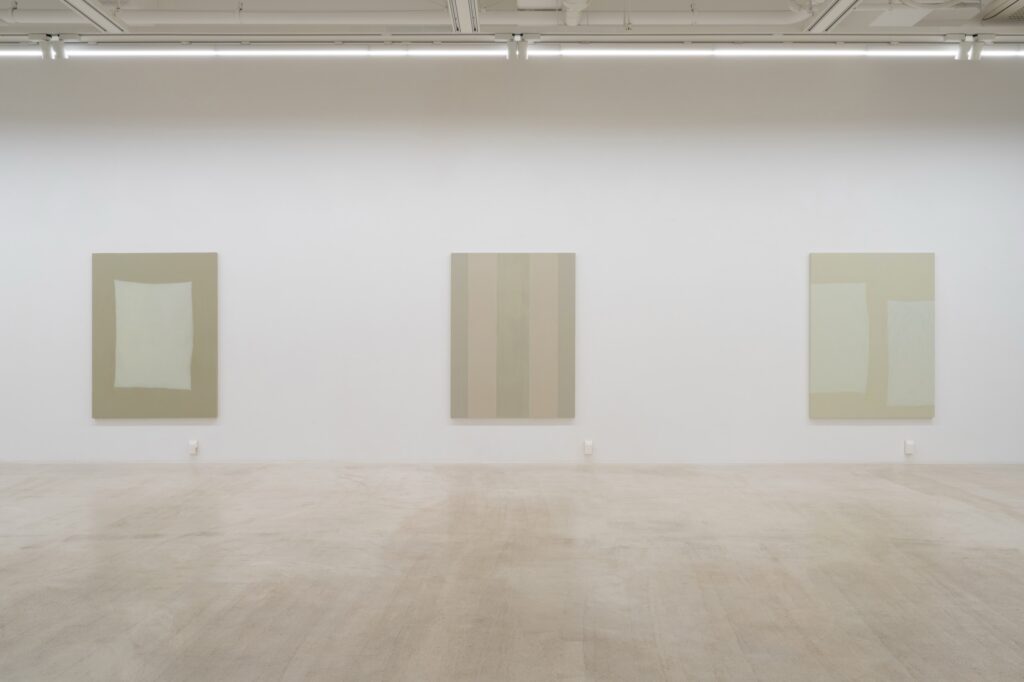
Q. 결국 두 분에게 ‘방심의 미’는 예술적 태도이자 삶의 방식이라고 볼 수 있네요.
최홍선: 그렇습니다. 예술이란 끝없는 조율이자 놓아주는 일의 반복이에요. 완벽에 가까워질수록 그것을 버릴 용기가 필요하죠. 저는 그 사이에서만 진짜 창작이 일어난다고 믿습니다. 완벽을 향해 나아가지만, 결국은 그 완벽을 넘어선 순간 새로운 것이 피어난다고 생각해요.
곽경화: 결국 ‘방심의 미’는 저희가 살아가는 방식이기도 해요. 완벽하지 않더라도 그 완벽을 위해 노력하려는 마음이요.
결국 완벽을 넘어선 아름다움은, 바로 그 마음에서 비롯된다고 생각합니다.
Q. 앞으로도 ‘방심의 미’를 향해 작품활동을 이어가실 텐데요. 두 분이 함께 협업하는 전시 계획은 또 있을까요?
최홍선: 지금까지는 한 공간 안에서 각자의 작품을 통해 서로의 세계가 만나도록 하는 협업을 해왔어요. 일종의 ‘병치된 공존’이었다면, 이번에는 조금 더 깊은 의미의 협업을 시도해보려 합니다. 예를 들어 하나의 캔버스 위에서 번갈아 그리는 방식이죠. 제가 먼저 시작하면, 다음 날 곽경화 작가가 그 위에 덧칠하고, 다시 그다음엔 제가 수정하는 식이에요. 그렇게 서로의 감각이 물리적으로 겹치고, 또 희미하게 스며드는 과정을 실험해보려 합니다. 작품이 완성되는 게 아니라, 서로의 결이 겹쳐지는 그 ‘중간의 상태’를 작품으로 남겨보고 싶어요. 두 세계가 만날 때 생기는 미묘한 온도 차, 그게 어쩌면 이번 작업의 핵심 주제가 될지도 모르겠어요.
곽경화: 저도 그 과정을 기록해 전시장 안에서 함께 보여드리고 싶어요. 단순히 결과를 보여주는 전시가 아니라, 두 사람이 ‘하나의 화면을 만들어가는 시간’을 관객이 함께 경험하는 형태로요. 서로의 붓자국이 남고, 또 지워지고, 다시 쌓이면서 만들어지는 자연스러운 흐름 속에서 협업의 본질이 드러날 거라 생각해요. 사실 진짜 협업이란 ‘누가 먼저 시작했는지조차 모르게 되는 일’ 아닐까요. 우리는 서로의 감각을 흡수하고, 다시 흘려보내면서 같은 화면 위에 두 사람의 시간과 온도를 쌓아갑니다. 그렇게 서로의 존재를 조금씩 남기고 또 비워내는 일, 그게 우리가 계속 함께 예술을 하는 이유이자, 앞으로도 탐구하고 싶은 주제입니다.
Q. In the end, the beauty of letting go seems to represent not only your artistic philosophy but also your way of life.
Choi: Yes, that is true. Art is an endless act of tuning and releasing. The closer we move toward perfection, the more courage it takes to let it go. I believe real creation happens only in that interval. We reach for perfection, yet something new is born only when we finally move beyond it.
Kwak: For us, the beauty of letting go is also a way of living. Even if we cannot be perfect, it is the desire to strive for it that matters. I believe beauty that transcends perfection begins from that very heart.
Q. As you continue to pursue this idea of the beauty of letting go, do you have plans for another collaborative exhibition?
Choi: Until now, our collaborations have taken the form of coexistence within the same space, where our individual works meet and converse. This time, we want to explore a deeper kind of collaboration. We are planning to paint on the same canvas, taking turns day by day. I might begin one day, then Kyounghwa will paint over it the next, and I will return to alter it again. Through this process, our sensibilities will overlap, blur, and seep into each other. What we want to capture is not a completed piece but the state in between, where our textures meet. The subtle difference in temperature when two worlds converge may become the key theme of this work.
Kwak: I also want to record that process and share it within the exhibition itself. Rather than presenting a finished result, we hope to let the audience experience the time of making one canvas together. As our brushstrokes remain, fade, and build again, the essence of collaboration will quietly emerge. Perhaps true collaboration is when you can no longer tell who began first. We absorb each other’s senses and let them flow again, layering our time and warmth on the same surface. Leaving traces of each other, then letting them go little by little, that is why we keep creating together and what we wish to continue exploring.
최홍선
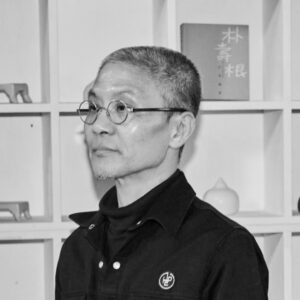
최홍선은 감정, 생각, 상상을 통해 인식을 넘어선 미묘한 ‘느낌’의 세계를 탐구한다. 언어로 규정할 수 없는 신비하고 모호한 실재를 작품 속에 투영하며, 다층적인 해석이 가능한 영역에서 예술의 힘을 찾는다. 회화, 도자, 설치 등 다양한 매체를 넘나들며 절제된 백색의 언어로 명상적이고 내면적인 세계를 구축한다. 서울을 비롯해 뉴욕, 나고야 등에서 13회의 개인전을 열었으며, 파리의 장식미술관(Musée des Arts Décoratifs), 제네바의 뮤제 드 카루주(Musée de Carouge) 등에서 단체전에 참여했다. 작품은 국립현대미술관 미술은행과 미국 머컨텔러 컬처럴 센터(Muckenthaler Cultural Center) 등에 소장되어 있다.
Choi Hongsun

Choi Hongsun explores a delicate realm of sensation that exists beyond perception, drawing from emotion, thought, and imagination. His works project the mysterious and ambiguous reality that cannot be defined by language, finding artistic power in spaces open to multiple interpretations. Moving fluidly across painting, ceramics, and installation, he constructs a meditative and introspective world through a restrained language of white. He has held thirteen solo exhibitions in Seoul, New York, and Nagoya, and has participated in group shows at the Musée des Arts Décoratifs in Paris and the Musée de Carouge in Geneva. His works are included in the collections of the National Museum of Modern and Contemporary Art, Korea, and the Muckenthaler Cultural Center in California.
곽경화
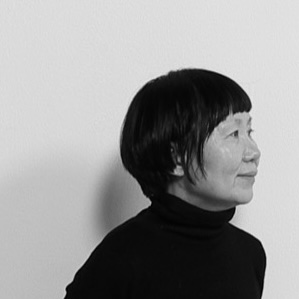
곽경화는 언어로 형상화할 수 없는 세계를 꿈과 상상의 결로 표현하며, 존재와 부재의 경계에서 아이러니한 감정을 탐구한다. 시간과 공간, 내면과 외면이 교차하는 지점에서 그녀의 작업은 추상적 화면과 유기적 형태로 확장된다. 일상의 미세한 감정과 사유를 시적 언어로 길어 올리며 도자, 회화, 설치 등 다양한 매체로 전개한다. 2020년 김리아갤러리 개인전 「가까이, 그리고 멀리서」를 비롯해 총 10회의 개인전을 열었으며, 2023년 이길이구갤러리의 《두 개의 방이 있는 집》, 클레이아크 김해미술관 《home SWEET home》, 제5회 세계도자비엔날레 《Space & Life》, 독일 아샤펜부르크의 NEUER KUNSTVEREIN ASCHAFENBURG e.V 등 국내외 기획전에 참여했다. 작품은 한국도자재단(이천)과 중국 상위의 Shangyu Celadon Modern International Ceramic에 소장되어 있다.
Kwak Kyounghwa

Kwak Kyounghwa expresses the indescribable through dreams and imagination, exploring the irony of existence and absence at the boundaries between time and space, the inner and the outer. Her work expands into abstract compositions and organic forms, drawing poetic reflections from delicate emotions within everyday life. She works across ceramics, painting, and installation, weaving sensitivity and rhythm into her practice. Kwak has presented ten solo exhibitions, including Close, and from Afar at Gallery Kimreeaa (2020), and has participated in major exhibitions such as A House with Two Rooms at Gallery Igealyigu (2023), home SWEET home at Clayarch Gimhae Museum, the 5th World Ceramic Biennale Space & Life, and NEUER KUNSTVEREIN ASCHAFENBURG e.V in Germany. Her works are part of the collections of the Korea Ceramic Foundation (Icheon) and the Shangyu Celadon Modern International Ceramic in China.
Epilogue
곽경화와 최홍선 작가는 작품 하나를 세우기까지 수없이 같은 과정을 되풀이한다. 그들에게 전시는 단순한 결과물이 아니라, 공간과 감정을 조율하는 ‘시뮬레이션의 시간’이다. 도면 위에서 벽의 높이를 맞추고, 빛의 결을 바꾸고, 간격을 조정하며 서로의 감각이 하나의 호흡으로 이어질 때까지 쉼 없이 반복한다. 그들의 태도는 집요하지만 결코 경직되지 않다. 완벽을 위해 모든 것을 통제하기보다, 우연이 스며들 자리를 만들어두기 때문이다. 그런 두 사람의 작업실에는 늘 빛의 방향이 다르고, 붓의 속도가 다르다. 그러나 어느 순간, 그 모든 차이는 하나의 리듬으로 겹쳐진다.
그들의 작업 속에는 서로를 향한 존중과 관객에게 다가가려는 마음이 묻어난다. 그래서일까, 두 사람의 다음 행보가 더욱 궁금해진다. 곽경화와 최홍선의 여정은 바로 ‘페어링Pairing’의 또 다른 형태다. 서로 다른 세계가 충돌하며 만들어내는 긴장, 그리고 그 속에서 피어나는 조화. 두 사람의 예술은 그 페어링의 과정 속에서 진화한다.
함께 호흡하고, 서로의 결을 조율하며, 다른 온도와 리듬을 한 화면 안에 공존시키는 일. 그것이 곽경화와 최홍선이 말하는 ‘방심의 미’이자, 《기아 디자인 매거진》이 주목하는 ‘페어링의 미학’이다.
Epilogue
To complete a single work, artists Kwak Kyounghwa and Choi Hongsun repeat the same process countless times. For them, an exhibition is never a mere outcome. It is a time of simulation in which space and emotion are finely tuned. On a floor plan, they adjust the height of walls, shift the texture of light, and recalibrate distance until their senses flow into a single rhythm. Their attitude is persistent but never rigid, for they leave room for coincidence to breathe rather than controlling everything in pursuit of perfection.
In their studio, the direction of light is never the same, nor is the speed of their brush. Yet at some moment, all these differences begin to overlap into one rhythm. Within their work lies a quiet respect for each other and a sincere desire to reach the viewer. Perhaps that is why their next step feels so intriguing.
The journey of Kwak Kyounghwa and Choi Hongsun is another form of pairing, a meeting of two distinct worlds that collide to create tension, and within that tension, harmony begins to bloom. Their art continues to evolve through this process of pairing, where two sensibilities breathe together, attune their textures, and allow different temperatures and rhythms to coexist within a single frame.
This, they say, is the beauty of letting go, and for Kia Design Magazine, it is the very essence of the aesthetics of pairing.